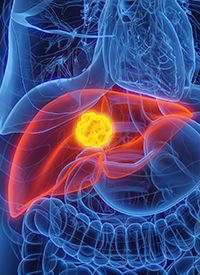Article
bTACE Plus Lenvatinib and MWA Produces Responses, Tolerability in HCC
Author(s):
Blank-microsphere transarterial chemoembolization plus low-dose lenvatinib and sequential microwave ablation elicited responses and a tolerable safety profile in patients with large hepatocellular carcinoma.
SciePro – adobe.stock.com

Blank-microsphere transarterial chemoembolization (bTACE) plus low-dose lenvatinib (Lenvima) and sequential microwave ablation (MWA) elicited responses and a tolerable safety profile in patients with large hepatocellular carcinoma (HCC), according to findings from the single-arm phase 2 Talem study (NCT05555316) presented at the 2023 ASCO Gastrointestinal Cancers Symposium.
The findings were presented in a poster session at the symposium, with research led by Zhimei Huang, MD, of the Sun Yat-sen University Cancer Center, in Guangzhou, China.
Per modified RECIST criteria, the trial reached its primary end point with an objective response rate (ORR) of 93.02% (n = 40), with 26 complete responses and 14 partial responses. Moreover, they observed a down-staging rate of 83.7% among the entire study group, with 8 patients achieving a complete response without MWA.
Huang et al observed a disease control rate (DCR) of 95.35% that remained the same per RECIST version 1.1 criteria; however, per RECIST version 1.1 criteria, the ORR was 18.6% with all 8 patients having a partial response. Per modified RECIST criteria, 1 patient had stable disease, but 33 patients had stable disease per RECIST version 1.1, while just 2 patients had progressive disease based off both criteria. Forty-one patients out of the evaluable 43 patients saw an over 30% decrease in their tumor size from baseline as well.
Researchers found a median progression-free survival (PFS) of 16.7 months (95% CI, 8.6-not reached) with the combination, and PFS rates among patients were 57.8% at 12 months and 34.6% at 24 months.
Durable results were also seen in patients’ overall survival (OS) rates with an 89.4% 1-year OS rate and a 67.5% 2-year OS rate.
The researchers also looked at 18 samples of peripheral blood mononuclear cells (PBMC) from patients given bTACE and low-dose lenvatinib. Looking at the variation of systemic immunity after treatment, they observed among the myeloid populations a decline of CD11b+CD33+HLA-DR–myeloid-derived suppressor cells after treatment (P < .05). They then observed an increase in activated CXCR5+CD8-positive and CXCR5+CD4-positive T cells after treatment (P < .05). Both observations provided the basis for the researchers’ conclusion that the use of this combination impacted both innate and adaptive anti-tumor immunity in patients with large HCC.
Of the 43 evaluable patients in the trial, the median age was 58 years (range, 50-65), and most were male (39 vs 4). Forty-two patients had an ECOG performance status of 0 compared with just 1 patient with an ECOG score of 1. Patients with large HCC on the trial had to have 3 or fewer tumors that had a diameter of 7 cm or greater at Barcelona Clinic Liver Cancer (BCLC) stage A/B. On the trial, 27 patients had BCLC stage A disease vs 16 patients with BCLC stage B disease. Of these, most of the patients’ disease was considered Child-Pugh class A vs Child-Pugh class B at 95.35% vs 4.65%, respectively.
Thirty-seven patients had 3 or more tumors compared with 6 who had more than 3, but the divide in tumor size was more evenly split with 22 patients who had tumors smaller than 100 mm, 18 patients with tumors between 100 mm and 150 mm, and just 3 patients with tumors larger than 150 mm.
Patients were given 4 mg to 8 mg a day of lenvatinib and were on bTACE for a median of 3 months. Participants also received a median of 20 ml of lipiodol and 8 ml of blank microspheres. Overall, 43 patients were given at least 1 cycle or more of lenvatinib and bTACE, but 13 patients did not receive additional MWA.
Four patients required a dose interruption of lenvatinib due to diarrhea, the patient’s decision, and an unlisted reason. Eight patients had to have a lenvatinib dose reduction, with 6 patients reducing their dose due to fatigue, 1 patient due to diarrhea, and 1 patient due to an unlisted reason. Overall, 25 patients discontinued treatment with 13 discontinuing due to disease progression, 3 were noncompliant, 1 due to diarrhea, 1 due to fatigue, 1 due to an unlisted reason, and 6 patients died while on the trial.
The most common adverse events (AEs) of any grade were fatigue (34.9%), proteinuria (32.6%), abdominal pain and diarrhea (13.9%), and hypertension (13.9%). The most common grade 3/4 AE remained fatigue (11.6%), but other grade 3/4 AEs included abdominal pain and diarrhea (4.7%), oral hemorrhage (2.3%), anorexia (2.3%), and hand-foot skin reaction (2.3%). For the researchers, this was deemed an acceptable toxicity profile to work with.
At the time of data cutoff, 18 patients remain enrolled in the phase 2 study as they look toward possible expansion of the trial.
Reference
Huang Z, Han X, Jiang Y, et al. A prospective single-arm phase II study of blank-microsphere transarterial chemoembolization (bTACE) plus lenvatinib (LEN) and sequential microwave ablation (MWA) in patients with large hepatocellular carcinoma (L-HCC, ≥ 7 cm): The Talem trial. J Clin Oncol. 2023;41(suppl 4):567. doi:10.1200/JCO.2023.41.3_suppl.567








